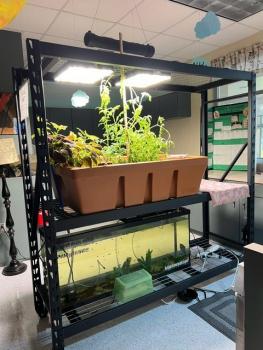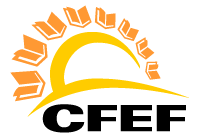
FIND IT FUND IT FLORIDA
Classroom Aquaponics Bringing Chemistry to Life

- School:
- Oakridge Middle
- Subject:
- Science
- Teacher:
- Maria Hill (LaRocco)
- Students Impacted:
- 160
- Grade:
- 8
- Date:
- August 2, 2025
0% Funded
Only $726.00 Needed
Goal
a) What is the overall purpose of this project and what need(s) does it address?
The purpose of this project is to upgrade an existing classroom aquaponics system to provide a more robust, sustainable, and engaging platform for science instruction. The original system was built using repurposed and makeshift materials as a pilot to determine whether aquaponics could enhance student understanding of middle school chemistry concepts aligned with Florida’s science standards. After two full years of implementation and data collection, results have demonstrated that this approach not only deepens conceptual understanding but also significantly boosts student performance.
This need for an upgrade is driven by the strong outcomes already achieved. On the most recent State Science Assessment, 70% of my students achieved a passing score, compared to the statewide average of 49%. Among English Language Learners, my classroom saw a 38% pass rate—more than double the state average of 18%. All of my advanced students (100%) passed. These gains are particularly impressive given the challenges of teaching complex chemistry concepts to a diverse student population using a makeshift system.
To maintain and build upon these gains, the aquaponics system must now be upgraded with durable, classroom-appropriate materials. A more reliable setup will allow for broader instructional use, better accommodate growing class sizes, and minimize instructional disruptions due to equipment failure. The project addresses the need for equitable access to high-quality, real-world STEM learning tools that are proven to elevate academic achievement.
b) What learning goals or academic outcomes does the project address?
This project addresses student mastery of key Florida middle school chemistry standards, including SC.8.P.8.7 (atomic theory), SC.8.P.9.1 (law of conservation of mass), and SC.8.P.9.2 (chemical and physical changes). The upgraded aquaponics system will allow students to explore these standards through direct application—monitoring chemical reactions in nutrient cycling, testing water quality, and observing real-time changes in matter within a living ecosystem.
Through this hands-on approach, my students develop a deeper understanding of scientific processes, data collection, and experimental design. The strong results from the previous year demonstrate that this method not only supports standards mastery but also improves performance across diverse student groups. The upgraded system will ensure consistent access to these learning experiences, resulting in higher academic achievement, stronger critical thinking skills, and a more equitable learning environment for all students.
Category
Learning Aids - Sunshine state book sets, robotics kits, puzzle boards, science models, engineering supplies, etc.
What will be done with my students
a) Describe the project and its activities.
This project involves upgrading an existing aquaponics system used as an instructional tool in a middle school science classroom. The current system, originally built from repurposed and makeshift materials, has been piloted over the last two school years to support student learning of chemistry standards through hands-on, inquiry-based learning. The upgraded version will include high-quality components such as a reliable water filtration system, grow beds, water testing kits, and nutrient monitoring tools. These materials will increase the system’s efficiency, safety, and instructional utility.
The project activities will include:
• Assembling and calibrating the upgraded aquaponics system
• Integrating the system into weekly lessons on chemical properties, physical and chemical changes, conservation of mass, and atomic theory
• Engaging students in long-term investigations that include water testing, system monitoring, data analysis, and reporting
• Using the system as a platform for group-based inquiry projects, cross-curricular writing assignments, and science fair experiments
• Allowing students to take on rotating roles (chemist, system engineer, biologist, data analyst, etc.) to build science identity and career awareness
Students will regularly test water parameters such as pH, ammonia, nitrites, and nitrates, and apply their understanding of chemical reactions to interpret the data. Observations and results will be documented in science notebooks, aligned with Florida’s science and literacy standards.
b) How will this project meet the needs of my students?
This project meets the needs of my students by making abstract chemistry concepts concrete and accessible. Middle schoolers often struggle to visualize and apply content like chemical reactions, atomic structure, and the conservation of mass. The aquaponics system creates a living, interactive model where students can observe these phenomena in action. This approach is especially impactful for English Language Learners and students with diverse learning needs, who benefit from visuals, repeated observations, and hands-on experiences.
At the classroom level, the project promotes student engagement, collaboration, and ownership of learning. It also supports interdisciplinary connections with math, writing, and environmental science. The data already show that students in this setting outperform the state average on science assessments—including a 70% pass rate overall and a 38% pass rate among English Language Learners. Upgrading the system will help maintain and amplify this success while reducing instructional disruptions due to system malfunctions.
At the school level, this project contributes to a culture of innovation and excellence in science instruction. It supports school improvement goals around STEM achievement, engagement, and equity.
Benefits to my students
a) What will improve/change for my student because of this project?
Upgrading the aquaponics system will lead to multiple positive changes for students. First and foremost, it will deepen their understanding of key chemistry concepts through consistent, hands-on engagement with real-world scientific processes. Students will gain a more meaningful grasp of topics like the conservation of mass, chemical and physical changes, atomic structure, and the role of energy in reactions. Because they will regularly observe and interact with the system, students will be able to apply what they learn in class to tangible outcomes—strengthening both comprehension and retention.
Second, the upgraded system will foster greater student engagement and ownership of learning. The reliability and expanded capabilities of the system will allow students to take on long-term investigations, work in rotating science roles, and participate in collaborative research projects. This structure encourages critical thinking, curiosity, and the development of problem-solving and data analysis skills.
Importantly, the project is expected to continue closing performance gaps. The initial implementation demonstrated a significant boost in performance for English Language Learners and students at various academic levels. With a more efficient and accessible system, even more students will be able to participate meaningfully—supporting a more inclusive and equitable science classroom.
How will we measure these outcomes?
Student growth and project outcomes will be measured using both quantitative and qualitative data:
• State Science Assessment Scores: Continued tracking of pass rates, with a focus on maintaining or improving the already strong performance compared to state averages, particularly among English Language Learners and students in advanced courses.
• Classroom-Based Assessments: Pre- and post-assessments aligned with Florida’s science standards will measure individual student growth in understanding chemistry concepts.
• Lab Reports and Science Notebooks: Students will document experiments, analyze data, and reflect on their findings. Rubrics will be used to assess scientific reasoning, accuracy, and content understanding.
• Participation and Behavior Metrics: Increases in on-task behavior, participation in lab work, and voluntary involvement in science-related activities (e.g., science fairs or clubs) will be tracked as indicators of increased motivation and interest.
By combining standardized test performance with classroom-based evidence, this project will demonstrate not just content mastery, but meaningful engagement with science as a discipline.
Budget Narrative
These grant funds will be used to replace and upgrade key components of our existing aquaponics system to ensure continued, effective instruction. Specifically, the grow bed will replace our current unit, which has developed a persistent leak and is no longer reliable for classroom use. The plumbing system—including the bell siphon, currently fashioned from a recycled water bottle—will be rebuilt using durable, classroom-safe materials to improve performance and reduce maintenance interruptions. The system also requires fresh grow media, as the current media has degraded over time; five 40-liter bags are needed to refill the bed. Students will use the included water testing kit and test strips to conduct regular monitoring of pH, ammonia, nitrites, and nitrates as part of their investigations aligned to Florida’s chemistry standards. Finally, our current filtration system has been running continuously for over 25,000 hours and will be replaced with a more efficient, aquarium-grade canister filter to ensure water quality and protect both fish and plants. These updates will make the system more reliable, scalable, and instructionally valuable throughout the school year.
Items
| # | Item | Cost |
|---|---|---|
| 1 | 1x AquaUrban Aquaponics Grow Bed | $260.00 |
| 2 | Plumbing Kits - Bell Siphon Plumbing Kit | $30.00 |
| 3 | Plumbing Kits - Flood and Drain Plumbing Kit | $30.00 |
| 4 | Grow Media - 5 bags of 40L Grow !T Planting Media | $185.00 |
| 5 | Water Test Kit | $36.00 |
| 6 | Nutrient Monitoring Strips | $50.00 |
| 7 | Penn-Plax Cascade 1000 Aquarium Canister Filter – Provides Physical, Biological, and Chemical Filtration | $135.00 |
| Total: | $726.00 |
0% Funded
Only $726.00 Needed





Share
Please share this page to help in fulfilling this grant.
Email to a Friend